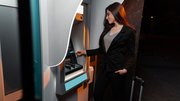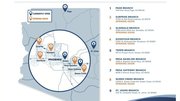News
Lots of cool stuff at The Kiosk Show
From virtual reality software to sophisticated coin counters to kiosks shaped like trees and spaceships, attendees at the recent Kiosk Show in Orlando, Fla., saw some of the most exciting self-service technology around.
March 16, 2005
ORLANDO, Fla. - Amid palm trees and ferns, more than 440 kiosk industry leaders and newcomers viewed exciting self-service wares at The Kiosk Show. Attendees, who ranged from novice to executive, walked away from the biannual show at the Gaylord Palms Resort with a little more knowledge under their belts. (Disclosure: The Kiosk Show is presented by ATMmarketplace's parent company, NetWorld Alliance.)
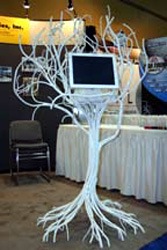 |
Shown above is D2 Sales' 'Tree of Knowledge' kiosk, a D2 original design created to show that kiosks can be more than just computers in boxes. |
A glimpse of the exhibition floor …
Order up: San Diego-based Apunix debuted its Mini Kiosk, a self-contained unit with a 10.4-inch monitor that's mounted in restaurant booths. The kiosk, like all of the company's machines, is built on a Linux platform with a Compact Flash chip-operating system. "It's a kiosk appliance, not a kiosk in a box," said Apunix President Peter Berens,
Using a touchscreen, restaurant patrons place and confirm their own orders at the Mini Kiosk. Six of the units were deployed in late 2004 at Budweiser's Brew House in the Miami Airport, Berens said. Apunix will roll out 40 more units at the Brew House in the next quarter.
A tree grows in Orlando: Milwaukee, Wis.-based D2 Sales caught attendees' attention with its Tree of Knowledge and Burger King Kids Virtual Fun Center kiosks.
The Tree of Knowledge, designed by D2 Sales founder Sandra Nix, shatters the notion that a kiosk is simply a computer in a box. "It's the anti-box," Nix said of the unique tree design.
Nix designs kiosks that promote her customers' brands, not D2's. "Every company has a certain style, but you'll never look at a D2-built kiosk and know that it's D2. Our intent is to be invisible, so that we're building kiosks to promote the brands of our customers, not our own.".
For the Burger King project, D2 and partner NuWay Technologies, a steel fabricator, just released a third-generation unit of the Burger King Kids Virtual Fun Center with a design that's a cross between a robotic hamburger and a spaceship. Nix said the kiosk, on which kids can play games that feature graphics like burgers and fries falling from the sky, has helped Burger King build brand loyalty with its youngest customers.
D2 has deployed more 1,000 units in the United States, Canada, Central America and the United Arabic Emirates. All of D2's units are equipped to run on Apple Macintosh OS/10 or Microsoft Windows.
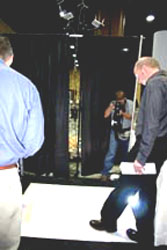 |
Show attendees weren't shy about trying their feet at GestureTek's GroundFX - an interactive, retail-use application that allows shoppers to interact with living advertisements. |
Ground control to major buzz: In the GestureTek booth, attendees interacted with advertisements via the GroundFX system, a projector shooting video images on the ground, and a football goal-shaped device GestureTek calls HoloPoint.
With GroundFX, visitors could chase and touch 3-D images on the floor. The HoloPoint system, which detects movement and direction when users wave their hands within the HoloPoint tracking frame, is like a touchscreen that can be "as interactive as you want it to be," said Ed Betts of GestureTek's New Business Development division.
GestureTek's virtual reality software is currently being used in Gesture Xtreme virtual reality kiosks deployed in theme parks and educational institutions. Now Toronto-based GestureTek is marketing the same technology to retailers, Betts said.
Mod Minnod: The Kiosk Factory, a Toronto-based division of Feature Factory, showcased its newest kiosk, the modular Minnod. The Minnod can take on any design and peripherals, said Feature Factory industrial designer Helen Casanova. With a 17-inch monitor, it's one of the company's largest-screen kiosks.
It's good to be king: Ontario, Canada-based KING Products and Solutions Inc. grabbed attendees' eyes with its 30-inch LCD showing movie trailers while it towered above the G5 Plynth kiosk. Guy Markus, a senior sales executive, said KING is taking its impressive G4 base model and its 6-month-old G5 into the retail arena, developing more robust retail-based applications "that will better satisfy the hunger and need of the retail sector."
Running all of its systems on a Windows XP embedded platform, the G4 is primarily used for informational applications, while the new G5 will offer a little more flexibility for transactional applications and additional peripherals. They feature screens ranging in size from 18 inches to 40 inches.
Everybody knows Tio: Burnaby, B.C.-based Info Touch Technologies Corp. and California-based Palm Desert National Bank showed off their newest ATM/kiosk hybrid, Tio.
Tio, which translates as "uncle" in Spanish, describes a suite of kiosk applications, including check cashing and bill payment. All of Info Touch's kiosks, including those already found in retailers like Circle K and Exxon Mobil, will take on the Tio name.
Sam Shahbazi, Info Touch's executive vice president, said the goal is to make Tio a known brand among its target users, primarily consumers without bank accounts.
PDNB is working with Info Touch to track and monitor Tio's cash flow, said Sandra Hartfield, president and CEO of PDNB's Electronic Banking division. "We call it our 'reverse vault cash' program," she said. "We balance out the cash and monitor what's coming in."
The fx factor: Willett, Calif.-based METALfx showed off a design that looked more like a pinball machine than a kiosk. "We started in arcades in the 1980s, designing models that looked very similar to this," said Alan Manns, kiosk national sales manager, pointing to the retro-looking kiosk.
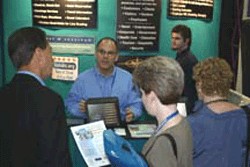 |
Attendees from Walt Disney Parks and Resorts spoke with an Apunix booth representative about diverse retail technologies during the show. |
Beyond the metal and woodwork, however, METALfx builds and designs its kiosks from the ground up.
Also on display was METALfx's standard, low-priced unit, the GEM, a multi-purpose payment kiosk. The GEM, which sells for about $4,000, comes standard with a 15-inch LCD touchscreen and steel enclosure. Peripherals can be added.
Surge sense: Zebulon, N.C.-based Electronic Systems Protection caught a few attendees off guard with a pop and a flash during its surge presentation on the showroom floor. Mike Honcomp, director of new market development, demonstrated how ESP's surge protector filters out ground noise to mitigate a surge, protecting kiosk networks from downtime. ESP also provides Ethernet, CAT 5 and telephone modem protection.
Coming to America: Taiwan-based XAC AUTOMATION CORP., a 12-year-old technology company, introduced its Linux-based Embedded System Kiosk during the show. "Because this is an open-source platform, it's more stable and easier to program," said Bosin Liu, XAC product manager.
The kiosk/ATM, which is being marketed for its financial capabilities, Liu said, comes equipped with a magnetic-stripe or smart-card reader, 5.7-inch screen, encrypting PIN pad and thermal printer.
XAC also showed off its more retail-oriented Windows-based Kiosk Model 4, introduced in 2004. It is a 15-inch touchscreen model, equipped with an encrypting PIN pad and thermal printer and the option to add a card reader.
Cash counter: Posen, Ill.-based Corporate Safe Specialists showed off its Self Out System, which hit the market in 2003. A Windows XP Pro-based kiosk, SOS is a customer-facing solution equipped with a touchscreen, coin-changer, coin and cash acceptor, coin- and cash-recycler and credit card payment device.
"The ability to give change is key with this system," said President Ed McGunn. "Thirty percent of customers will give exact change at the point-of-sale, if they have the option."
Using its coin recycler, SOS takes and counts change customers feed it - which limits the need to replenish the vault, McGunn said.
In the city: Myrtle Beach, S.C.-based Display Concepts Inc. showed off its KioCity, kiosk software that's been designed with the end-user in mind, said Kary Wall, vice president of development.
Wall said hospitality, retail and advertising industries, along with academic institutions, are the targeted users.
Display Concepts also designs kiosks, giving it the turnkey edge. On display was a 19-inch touchscreen kiosk the company deployed six months ago for Horry Georgetown Technical College in South Carolina. The college's students use the kiosks to register for classes, check schedules and locate professors' offices and classrooms.
Got front and back end covered: With Nanonation's CommandPoint software, said Brian Ardinger, director of business development, customers can remotely monitor their networks; NanoPoint software manages the system's front end.
On display at Nanonation's booth was a program the Lincoln, Neb.-based company developed for Mazda - a system that allows end-users to get specific information about Mazda vehicles. Nanonation also works with Target and Petro Travel Centers.
Nanonation worked with D2 Sales on its Burger King Kids Virtual Fun Center kiosk and Yahoo! Interactive bus shelter project. And like D2, Nanonation designs software that runs on Windows XP and Mac OS/10. The company is in the process of developing software for Linux as well.
Color commentary: Lancaster, Penn.-based MAX International introduced its two-color thermal receipt paper. With the two-color option, images can be targeted to specific customers' needs, said Michael Vigunas, MAX president.
"The messages aren't preprinted," he said. "For instance, you would scan your loyalty card and then you would have special advertisements and an individual message printed for the customer."
The technology is more expensive, but company representatives said studies have shown that sales increase an average of 70 percent when targeted receipt color printing is used at retail locations like grocery stores.


